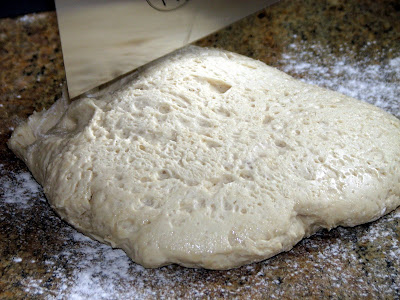
I had no hope at all for this very simple recipe for baguettes. I don't even know what possessed me to try it, except that my daughter Elizabeth had asked me for a bread recipe that used a food processor, and my daughter Sarah had asked me for Bittman's How to Cook Everything as a Christmas present. When I was leafing through the new, improved version of the cookbook, I ran across the recipe for "Easiest and Best French Bread." Oh, right, I thought. Toss four simple ingredients into a food processor, and then, when you think of it, give them a little shaping and bake. I'm sure that's going to make a good baguette.

I don't know why, but this easy-as-pie recipe turned out a better baguette than the Peter Reinhart version I made a few weeks ago where I laboriously sieved whole wheat flour to try to approximate "clear flour." It's not at all fair that something this easy should turn out so good, but there you are. It's a recipe that you should try anytime you feel like turning out a flavorful baguette but you don't want to start the process three days ahead of time.

The recipe consists of flour, water, salt, and yeast. Everything goes in a food processor for about 30 seconds. You gather up the dough--it's pretty wet--put it in a bowl and let it rise for a few hours.

Shape it into three loaves and put them into a French bread pan.

Let them rise again, slash them, and put them in the oven.

Take them out a half-hour later.

That's it! I don't know why one of the loaves looks so much more decorous than the other two--I guess the slashes weren't as deep.

I liked the way they looked when they came out of the oven. I liked the way they smelled. But I'd liked the way the poolish baguettes of a few weeks ago looked and smelled too, and then I was disappointed when I tasted them. But these tasted really good--so much better than I expected. I've considered the possibility that it was just my low expectations that made me so impressed with the way these loaves turned out. Since I expected nothing, any result above nothing would be good. But I don't think so. The outside is crusty but not hard, the inside is chewy and full of rich flavor. If I bought it at a bakery, I'd go back for more.
Everyone knows Mark Bittman is the one who popularized no-knead bread, the craze of a few years ago. But maybe it's this food processor baguette that really deserves the popularity.
Easiest and Best French Bread
--from How to Cook Everything, by Mark Bittman
3 1/2 cups (546 grams) bread flour
2 tsp. salt
1 tsp. instant yeast
1 1/2 cups water (or more)
1. Process flour, salt, and yeast for a few seconds in food processor, using the metal blade. With the machine running, pour most of the water through the feed tube. Process about 30 seconds, or until dough becomes a sticky, shaggy ball. If it doesn't feel sticky, add more water.
2. Turn dough into large bowl, and cover with plastic wrap. Let rise for two to three hours at room temperature.
3. Sprinkle a little flour on the counter, and cut dough into three equal pieces. Shape each into long roll, and place in a lightly floured baguette pan. Cover with a towel, and let rise for another one to two hours. (On a cold day, you'll need the full rising time).
4. About a half-hour before baking, put baking stone in oven, and skillet or pan on lowest shelf. Preheat oven to 450 degrees. When ready to bake, slash loaves with sharp knife and sprinkle lightly with flour. Put about 1/2 cup of ice cubes on pan on lowest shelf of the oven, and quickly put baguette pan on top of baking stone.
5. Spray sides of oven after five minutes and again after ten minutes.
6. Bake 25 to 35 minutes, until crust is golden brown. Cool on a wire rack.















